Today we’re taking a look at the new Radeon RX 7900 “GRE” – so not the 7900 XTX or XT – but rather the GRE. For those unfamiliar with the 7900 GRE, AMD announced it about a month ago. The “GRE” stands for “Golden Rabbit Edition,” a super odd name for a gaming graphics card. The name choice stems from the fact that 2023 is the year of the rabbit in Chinese culture. As we understand, the 7900 GRE was designed to be exclusive to the Chinese market, and that’s mostly still the case. We’ll elaborate on this.
The Radeon 7900 GRE can be purchased as a standalone item, specifically as a DIY component in China. However, in some regions, like Australia, there’s a caveat: it’s only available in full system builds. So, despite having a $650 MSRP, it’s not available for that price in the US. One would need to seek a system integrator that offers it.
In Australia, PLE is the sole retailer offering the 7900 GRE. So we went over their website, configured the most affordable system possible with the GRE, made the purchase, and awaited its arrival. Our experience with PLE was seamless. Once the system was ready, we promptly collected it, raced home, ripped the graphics card out, stuck it in the 7800X3D test system and got to work.
Specification-wise, the 7900 GRE is a pared-down 7900 XT, featuring less of basically everything. It shares the same Graphics Compute Die as the XT and XTX versions. Though there are six Memory Cache Dies (MCDs), only four are active. It also houses just 80 Compute Units, which translates to 5,120 Stream Processors – a 5% reduction compared to the XT and 17% fewer than the XTX.

The memory subsystem witnesses the most significant downgrade. It comes with 16GB of GDDR6 compared to 20GB for the XT and 24GB for the XTX. Furthermore, with a 256-bit wide memory bus and 18 Gbps memory speed, you’re getting a bandwidth of 576 GB/s – 28% less than the XT.
While the GRE uses the Navi 31 die, its significant reductions raise the question of whether it should even be part of the 7900 series. The pressing question for us is: How does the Radeon 7900 GRE performance compare to the XT? And is it a sensible purchase in a pre-built system or as a DIY product in China?
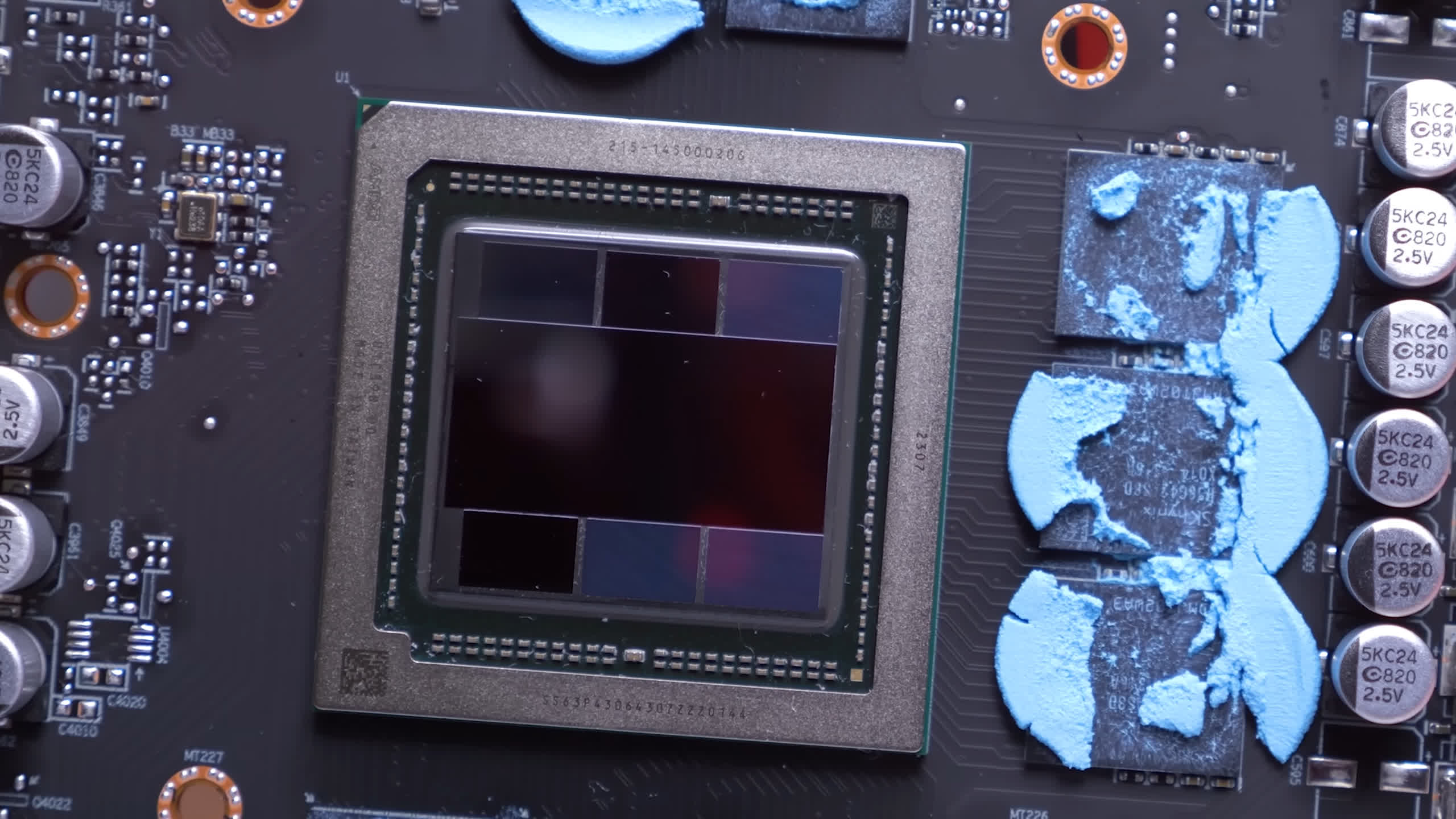
Well, let’s go find out. For testing we’re using our Ryzen 7 7800X3D test system with 32GB of DDR5-6000 memory, using the latest display drivers. We’ve validated and updated all data for this review. Later on we can present a comprehensive GPU comparison featuring current and past generation models. For now, we’ve tested the 7900 GRE in 15 games and will discuss results for half of them before diving into the average for all 15 games. Now, let’s dive into the details…
Benchmarks
First up, we have The Last of Us Part 1. Here, the GRE managed 79 fps at 1440p, making it just 4% faster than the 6800 XT. This already makes one wonder why it’s considered a 7900 series class product. It was also 5% slower than the 6950 XT, 11% slower than the 4070 Ti, but 8% faster than the standard 4070. Compared to the 7900 XT, we’re looking at a 20% reduction in performance, which aligns with the specifications.
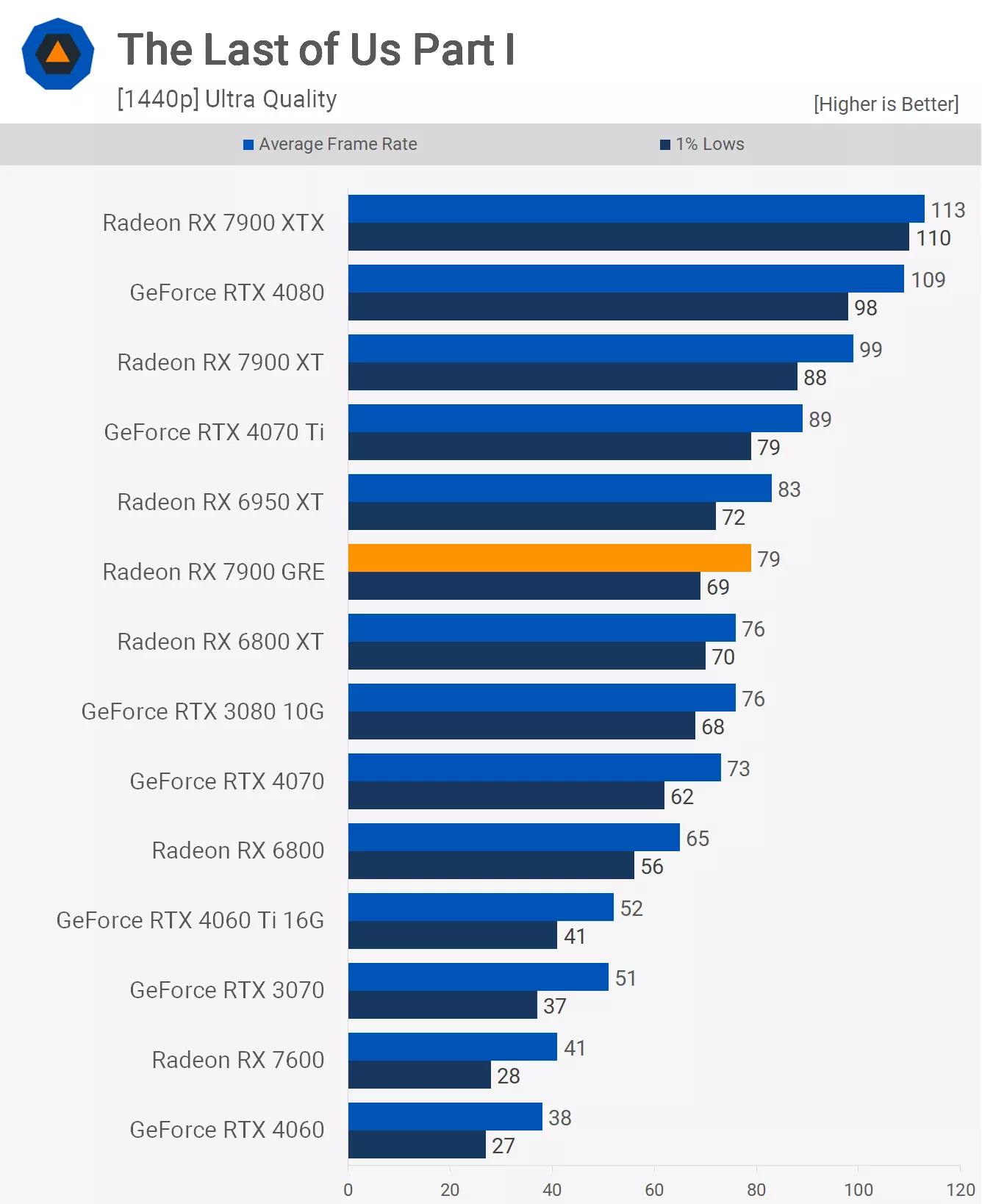
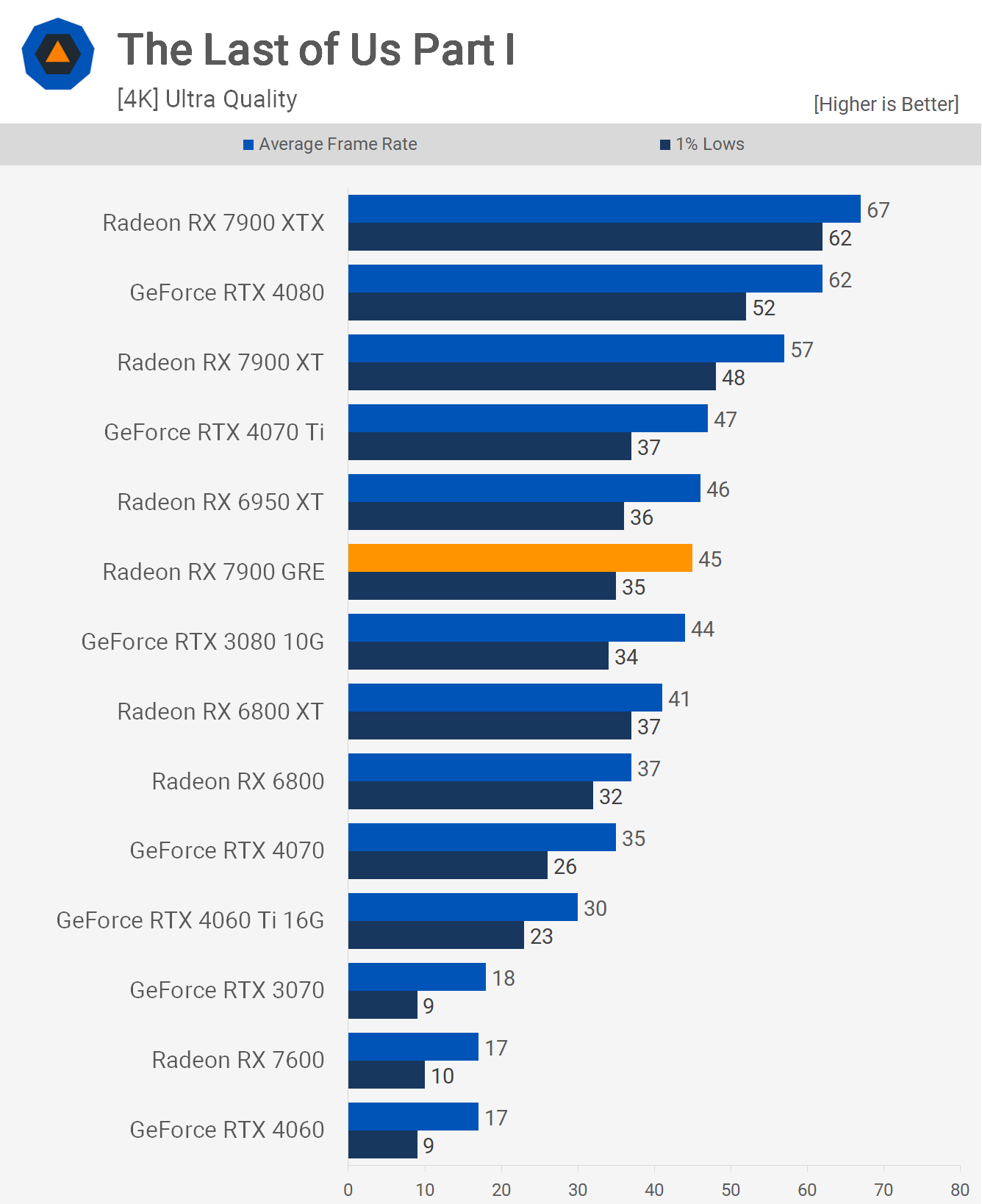
At the 4K resolution, we’re observing an average of 45 fps, mirroring the performance of the RTX 3080, 6950 XT, and 4070 Ti. This time, it was 21% slower than the 7900 XT.
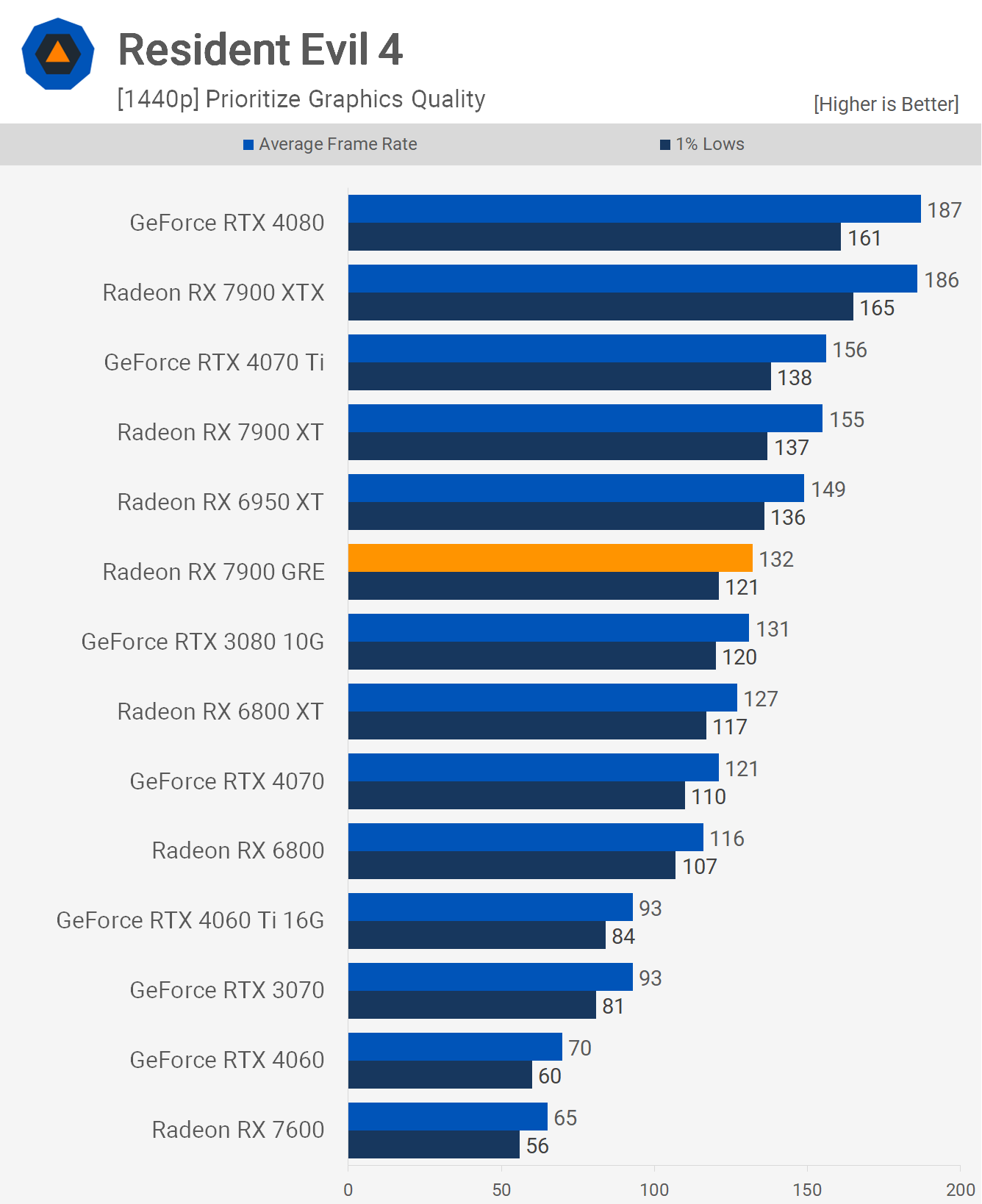
Next, we observed Resident Evil 4. In this game, the GRE averaged 132 fps at 1440p, which again aligns with RTX 3080 and 6800 XT performance levels. However, it was 15% slower than the 7900 XT. From what we’ve observed, the 7900 GRE seems like a slightly updated 6800 XT at the same MSRP.
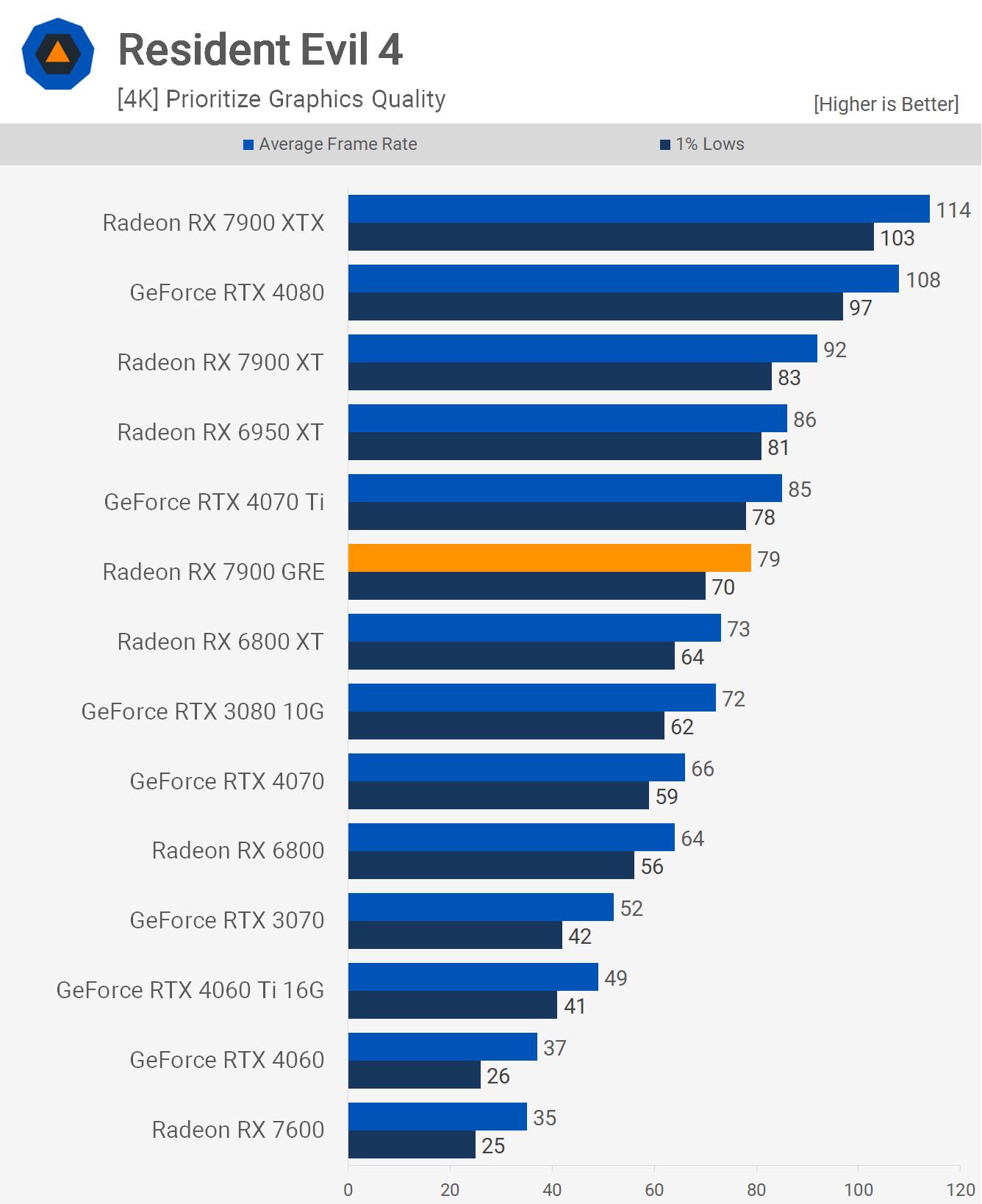
The GRE outperformed the 6800 XT by an 8% margin at 4K and was only 14% slower than the 7900 XT. Overall, these results are relatively promising.
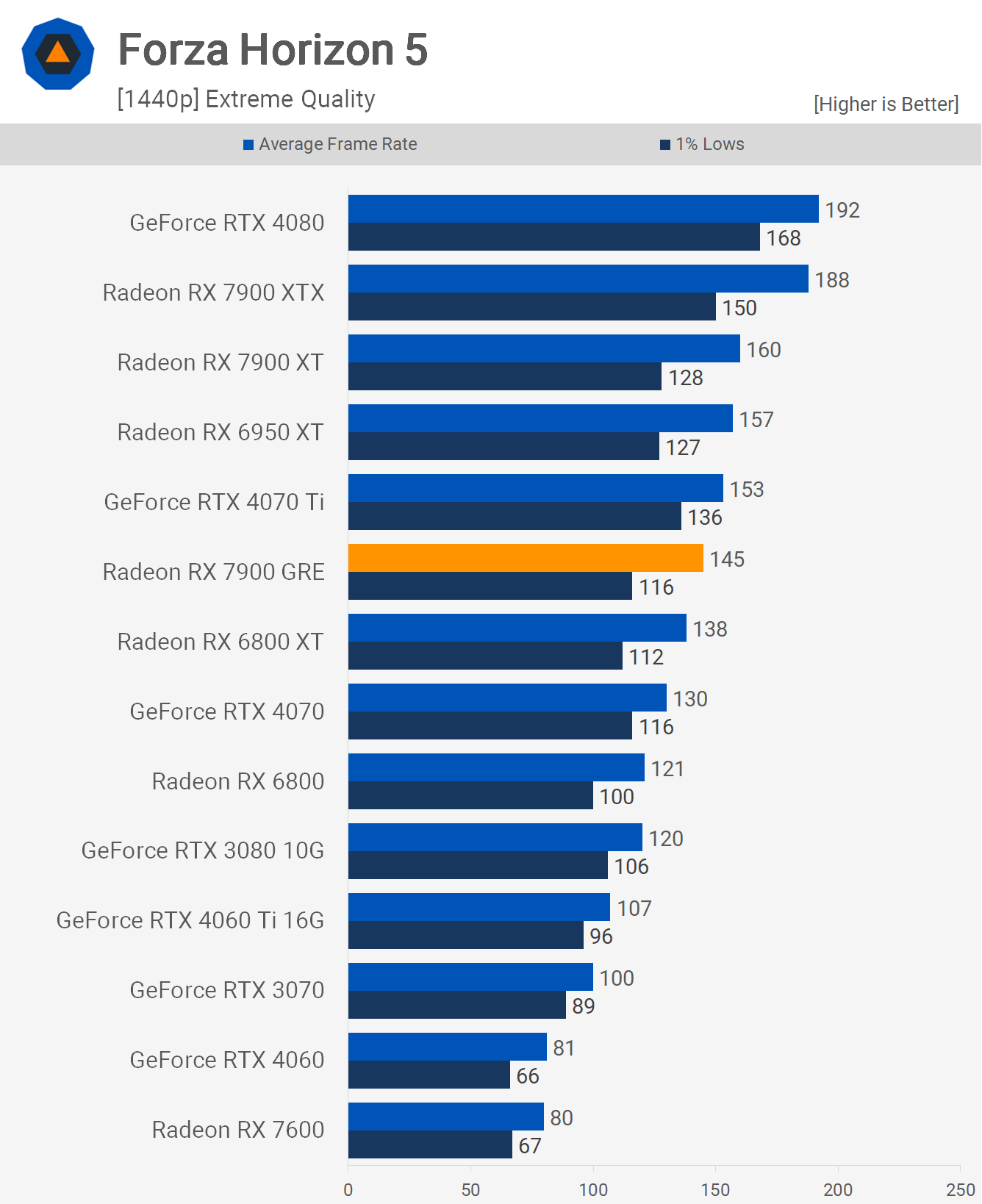
For Forza Horizon 5 at 1440p, we recorded an average of 145 fps, similar to the 6800 XT’s performance. In this test, it was 9% slower than the 7900 XT. While AMD has introduced driver improvements to boost RDNA 3’s performance in Forza, the results compared to RDNA 2 aren’t particularly impressive.
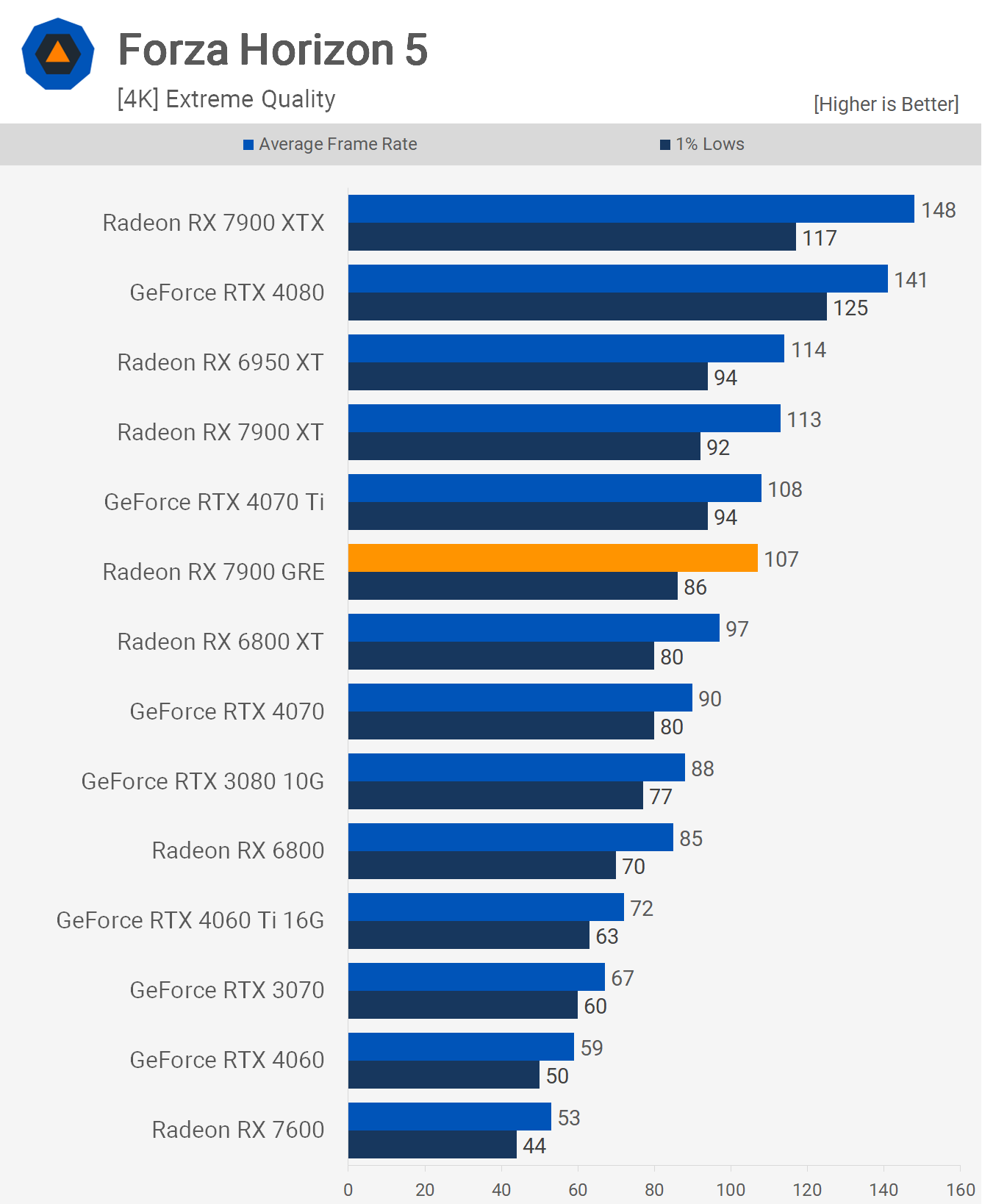
At 4K, the 7900 GRE’s performance was on par with the RTX 4070 Ti. It was 10% faster than the 6800 XT and only 5% slower than the 7900 XT, which is noteworthy.
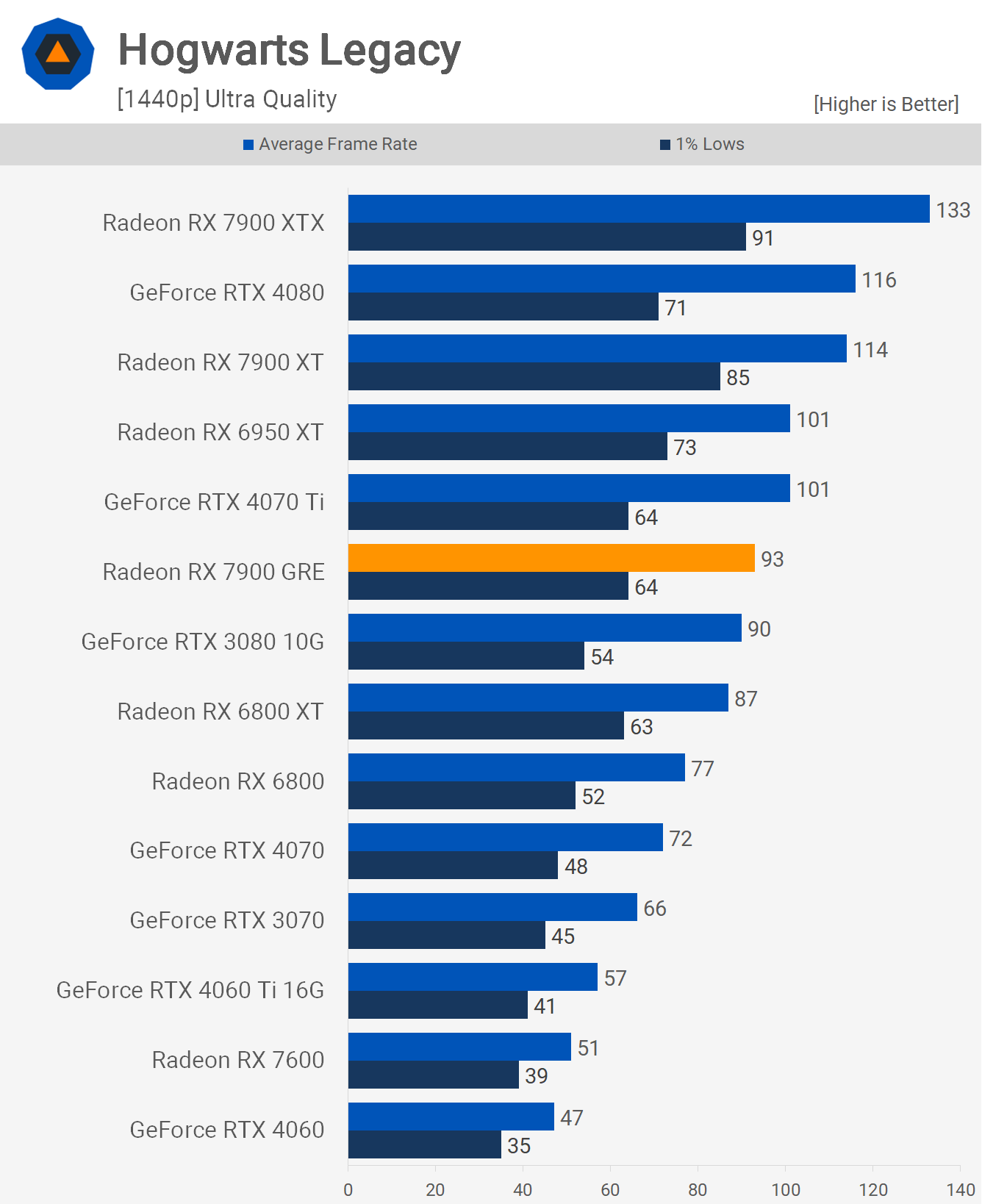
For Hogwarts Legacy, the GRE averaged 93 fps at 1440p, making it 3% faster than the RTX 3080 and 7% faster than the 6800 XT. However, it lagged 18% behind the 7900 XT. Compared to the 4070 Ti, the GRE’s performance was commendable.
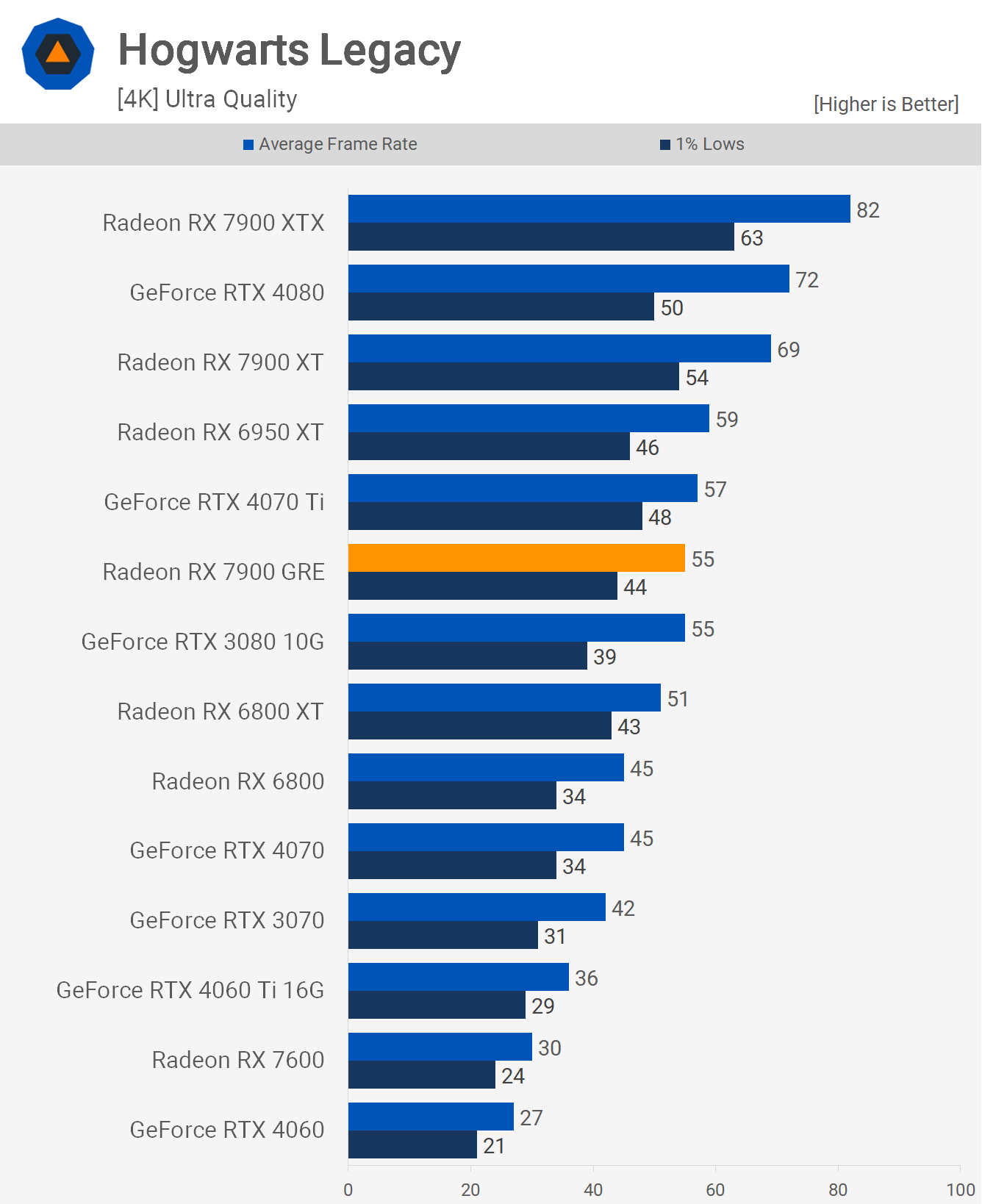
Interestingly, at 4K, the RTX 3080 matched the GRE’s performance. The difference with the 4070 Ti was marginal. When compared to the 7900 XT, the GRE was 20% slower, which is in line with the specifications.
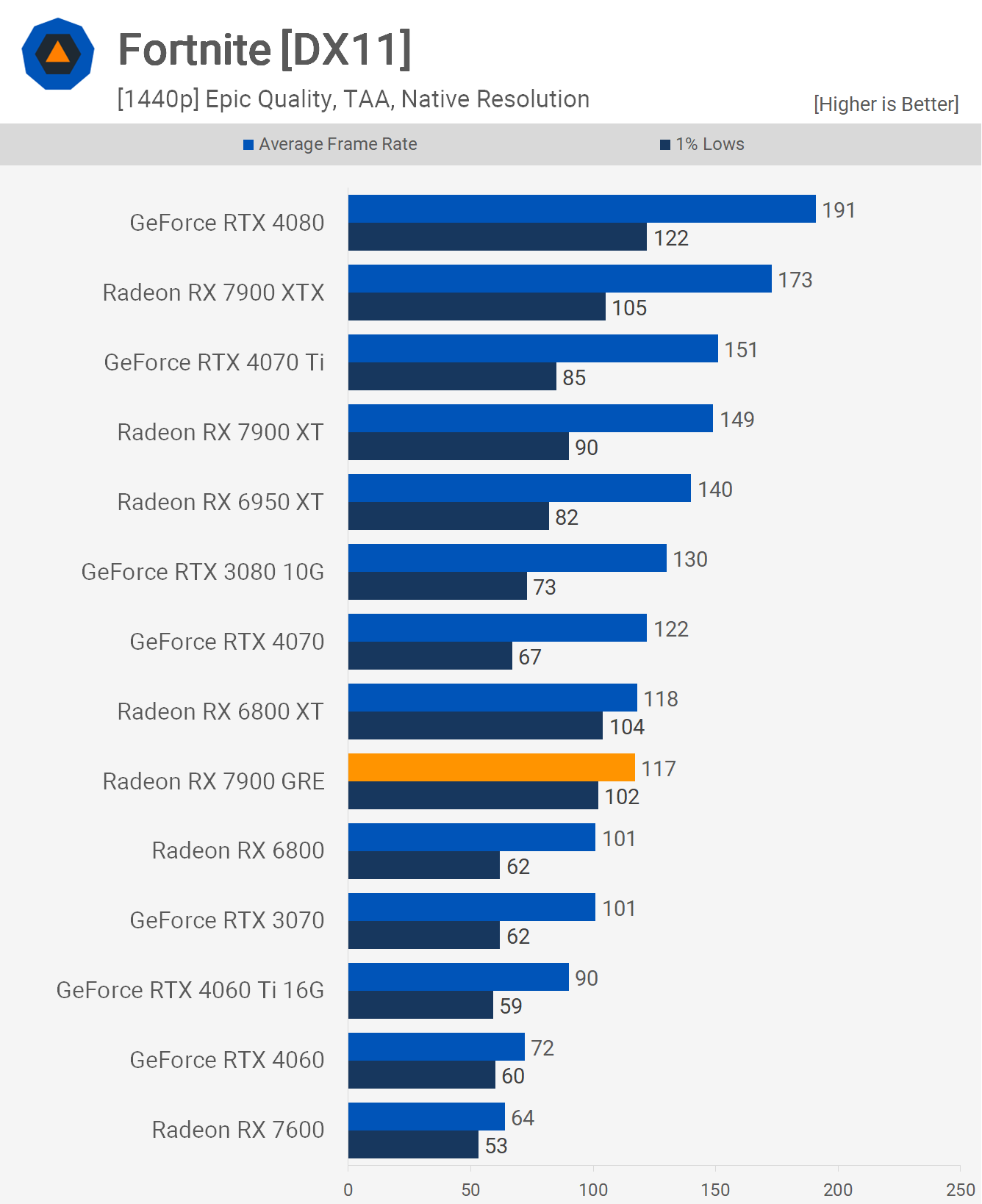
Fortnite’s performance wasn’t stellar, with an average of 117 fps at 1440p. This placed the GRE behind most competitors, closely aligning with the 6800 XT and RTX 4070. It was 21% slower than the 7900 XT.
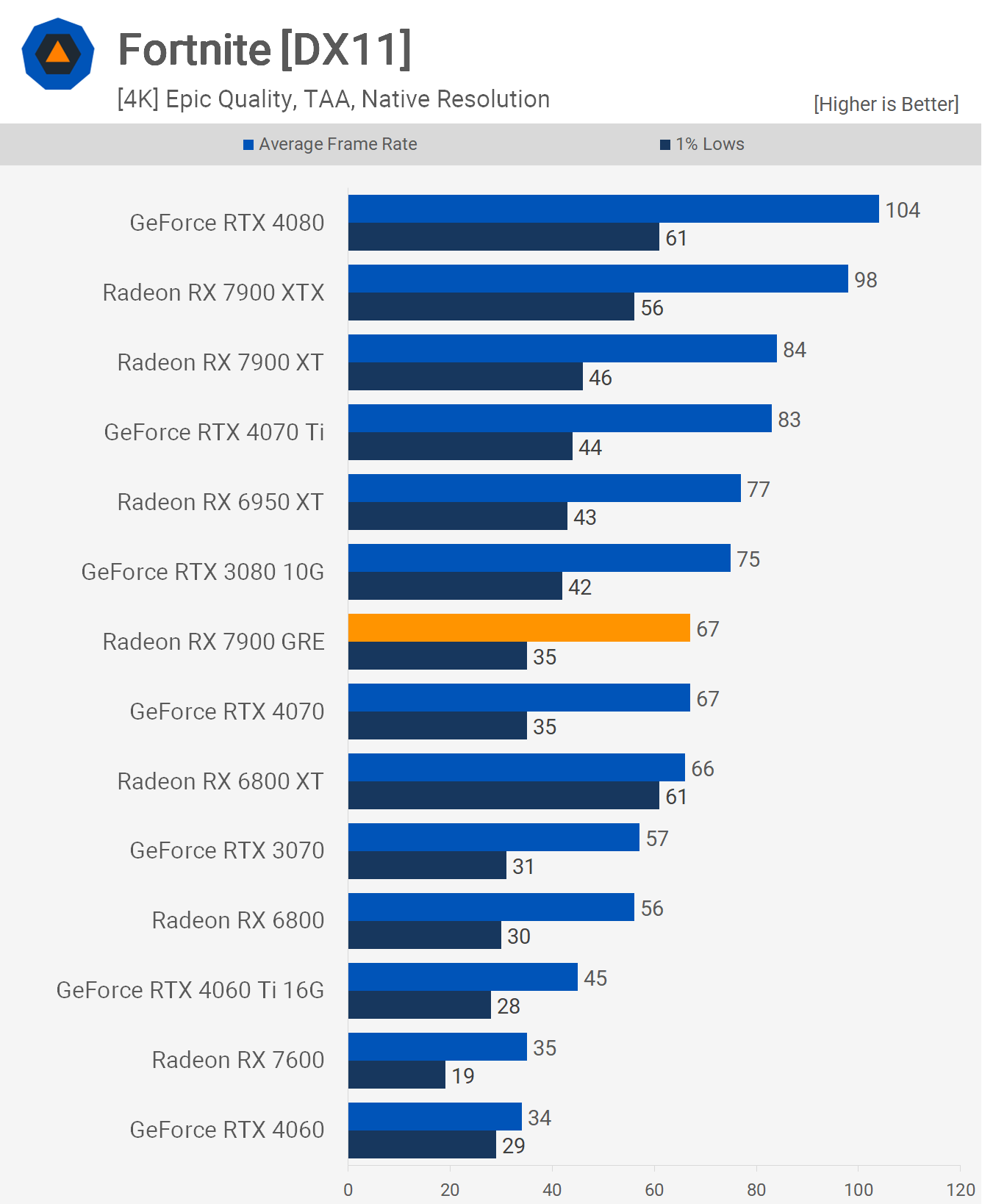
4K results weren’t more promising for the GRE. Averaging 58 fps, it struggled to compete with cards like the 4070 Ti and 7900 XT. At this point, it’s clear that the 7900 GRE is meant for those looking for 6800 XT-like performance at a similar price point.
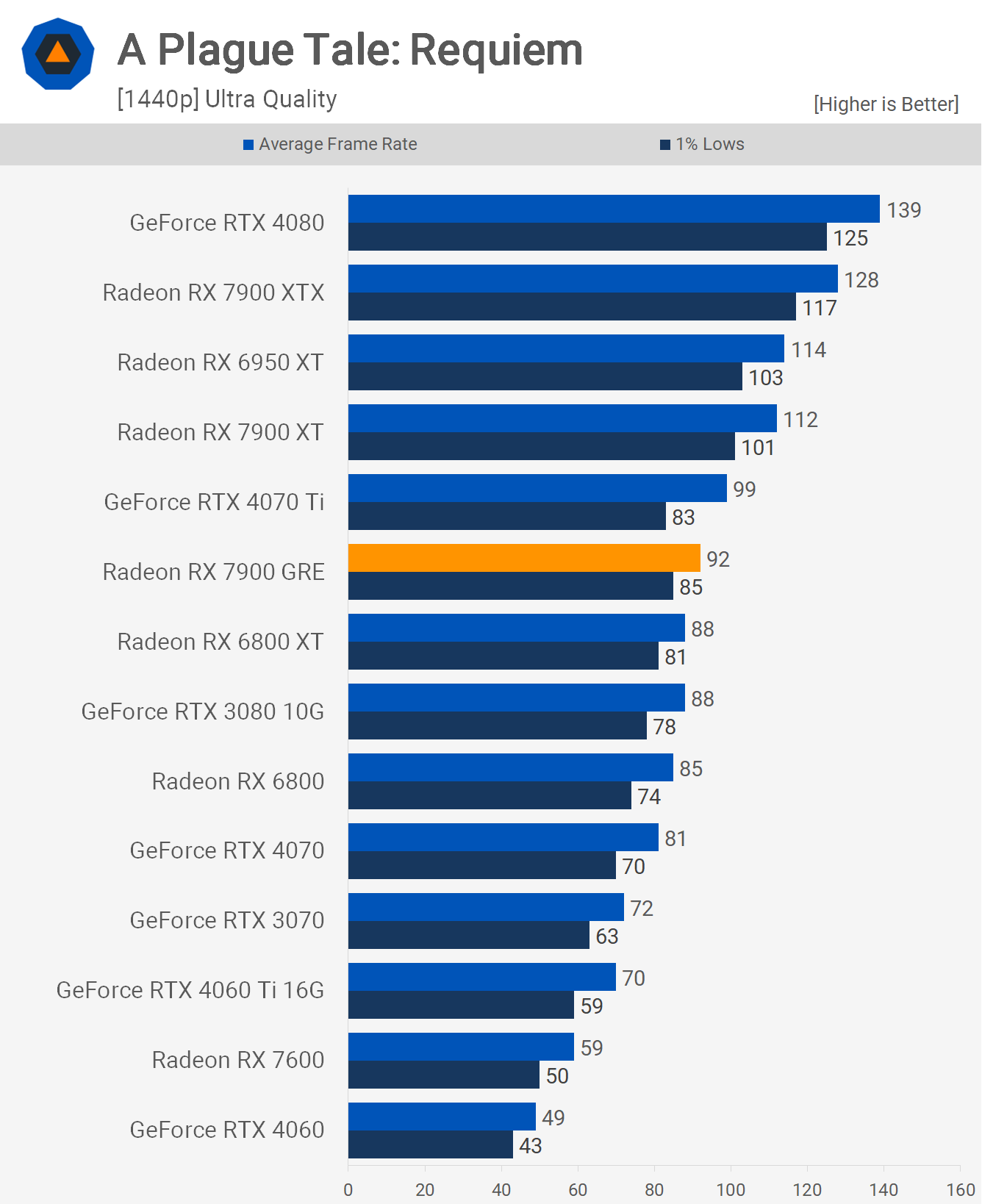
The last game we’re going to examine in terms of individual data is A Plague Tale: Requiem. Here, the 7900 GRE achieved 92 fps at 1440p. This made it 5% faster than the 6800 XT and RTX 3080, and 18% slower than the 7900 XT.
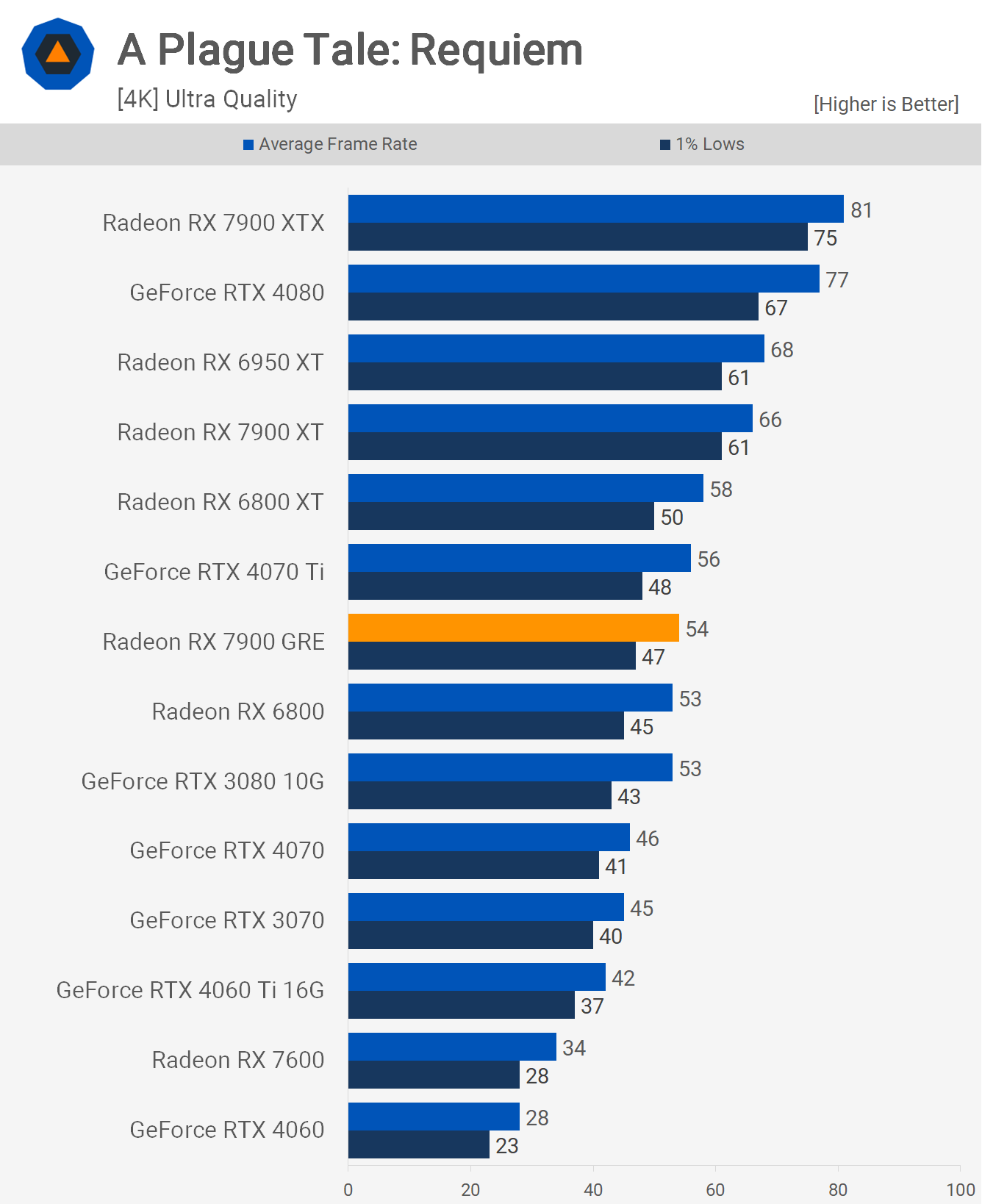
At the 4K resolution, it fell behind the 6800 XT and was again 18% slower than the 7900 XT. However, its performance relative to the RTX 4070 Ti was commendable, delivering 17% more frames than the standard 4070. The performance of Nvidia’s 4070 series paints the GRE in a more favorable light than it might otherwise deserve.
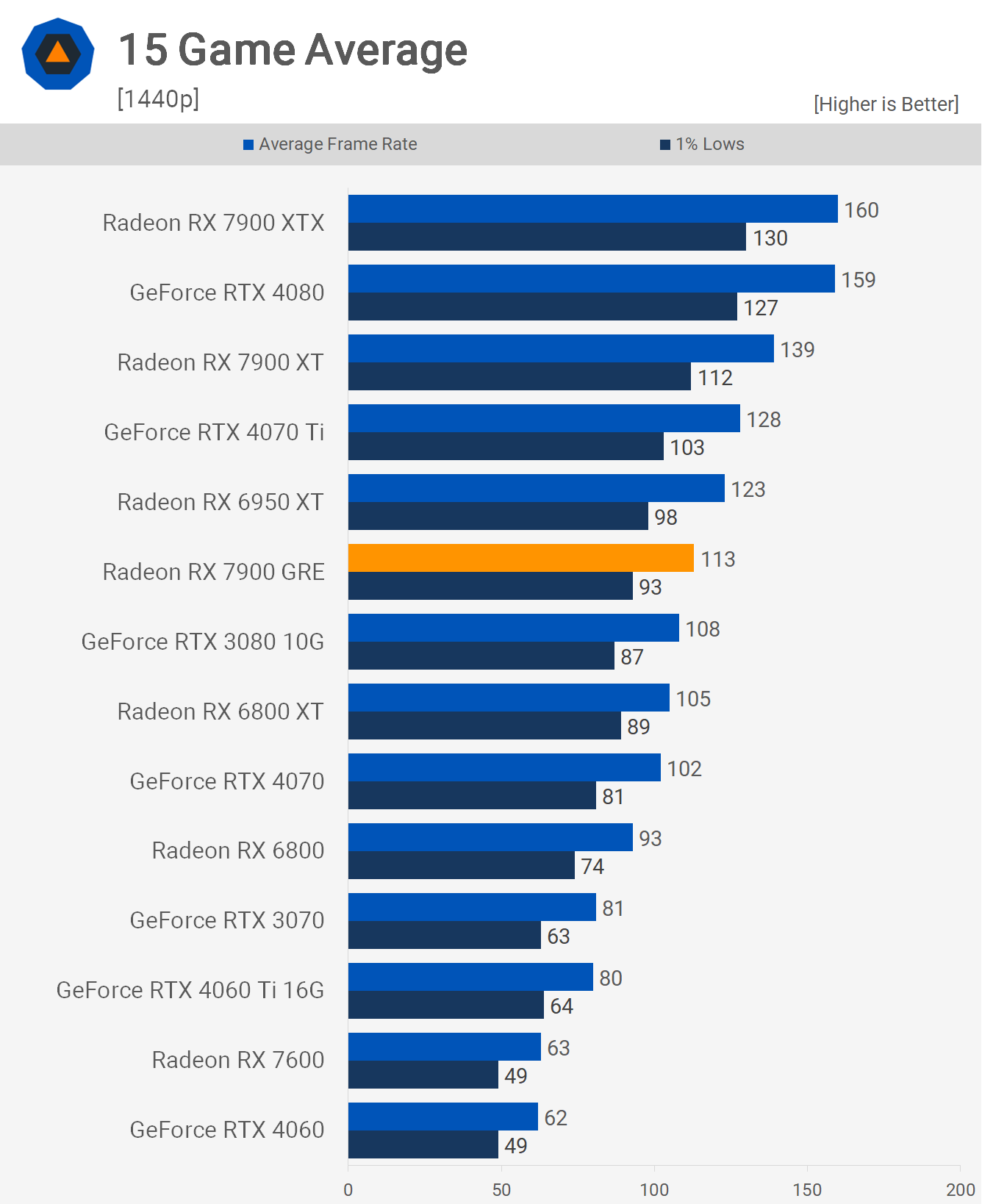
Now, looking at the 15-game average data at 1440p, the 7900 GRE averaged 113 fps. As we’ve observed multiple times, this places it on par with the RTX 3080 and 6800 XT in terms of performance, surpassing the 3080 by a mere 5% and the 6800 XT by 8%. It was also 11% faster than the RTX 4070, and based on the suggested retail price, should cost about 8% more.
When compared to the 7900 XT, we see 19% fewer frames on average, and it trailed the 4070 Ti by 12%.
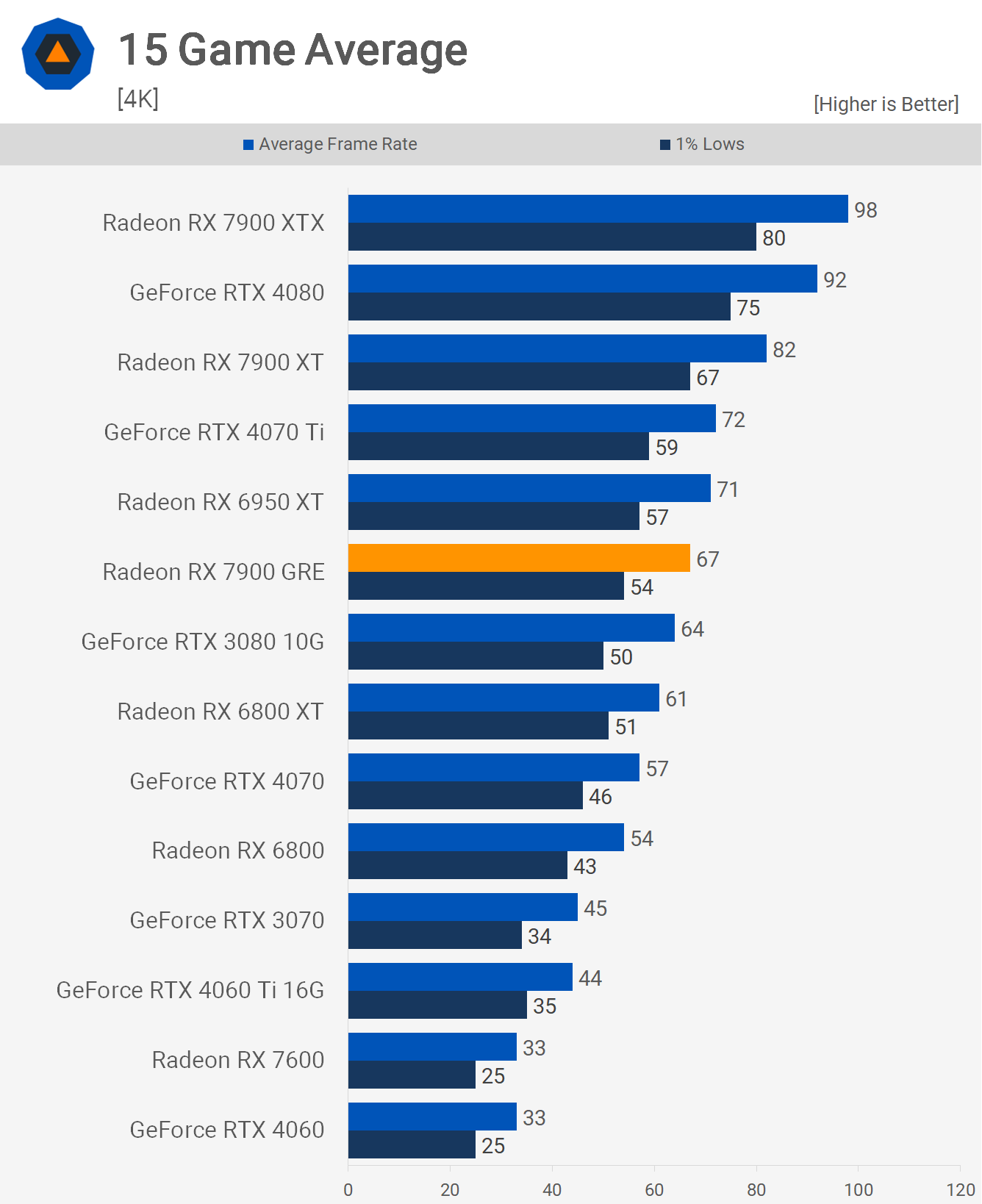
Increasing the resolution to 4K didn’t bring much change. The GRE remained 18% slower than the 7900 XT, 5% faster than the RTX 3080, and 10% faster than the 6800 XT. In essence, we’re witnessing an updated 6800 XT, nearly three years later, offering a 10% performance boost. We’ll delve into its potential enhanced power efficiency shortly.
Cost per Frame (MSRP)
Before diving deeper, we want to focus on the cost per frame data, starting with the MSRPs. The funny thing about the 7900 GRE is that it’s actually by far the best value high-end RDNA 3 GPU AMD has released, and ironically they haven’t really released it, given you can’t just go and buy one outside of China. Priced at $5.75 per frame, it offers slightly better value than Nvidia’s top value mid-range to high-end current generation GPU, the RTX 4070, and is 8% better value than the 7900 XTX. So, while a price of $650 might not seem impressive, it would be reasonably competitive compared to other options in this performance tier.
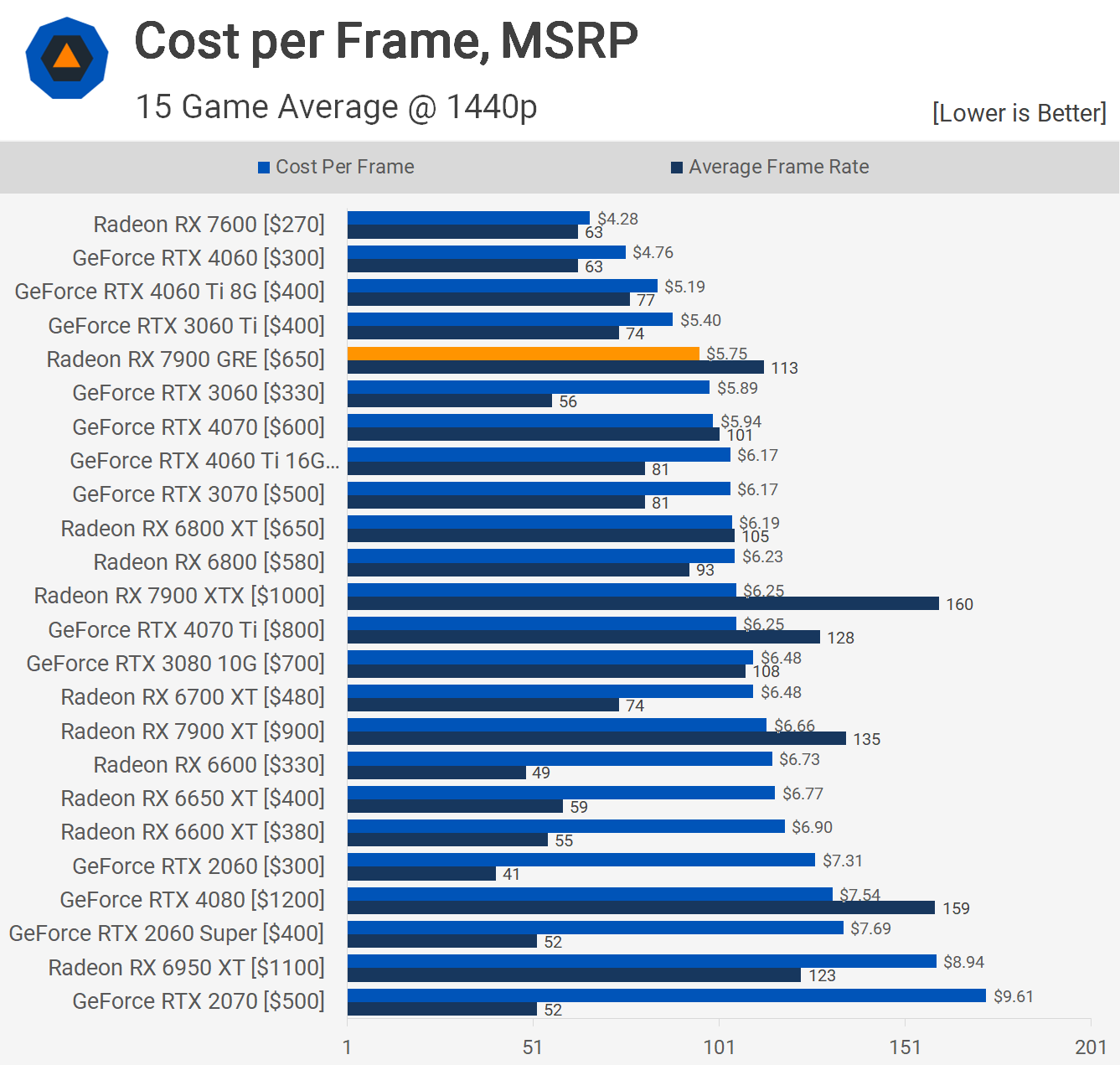
Cost per Frame (Retail)
Of course it’s the retail pricing that’s of most importance to you, so let’s take a look at the typical Newegg pricing for these GPUs. Here the 7900 GRE like most current generation GPUs makes little to no sense. While it’s certainly better value than the 4070 and 4070 Ti, both of which only come with 12GB of VRAM, it simply can’t hold a candle to the value of previous generation parts like the 6800 XT.
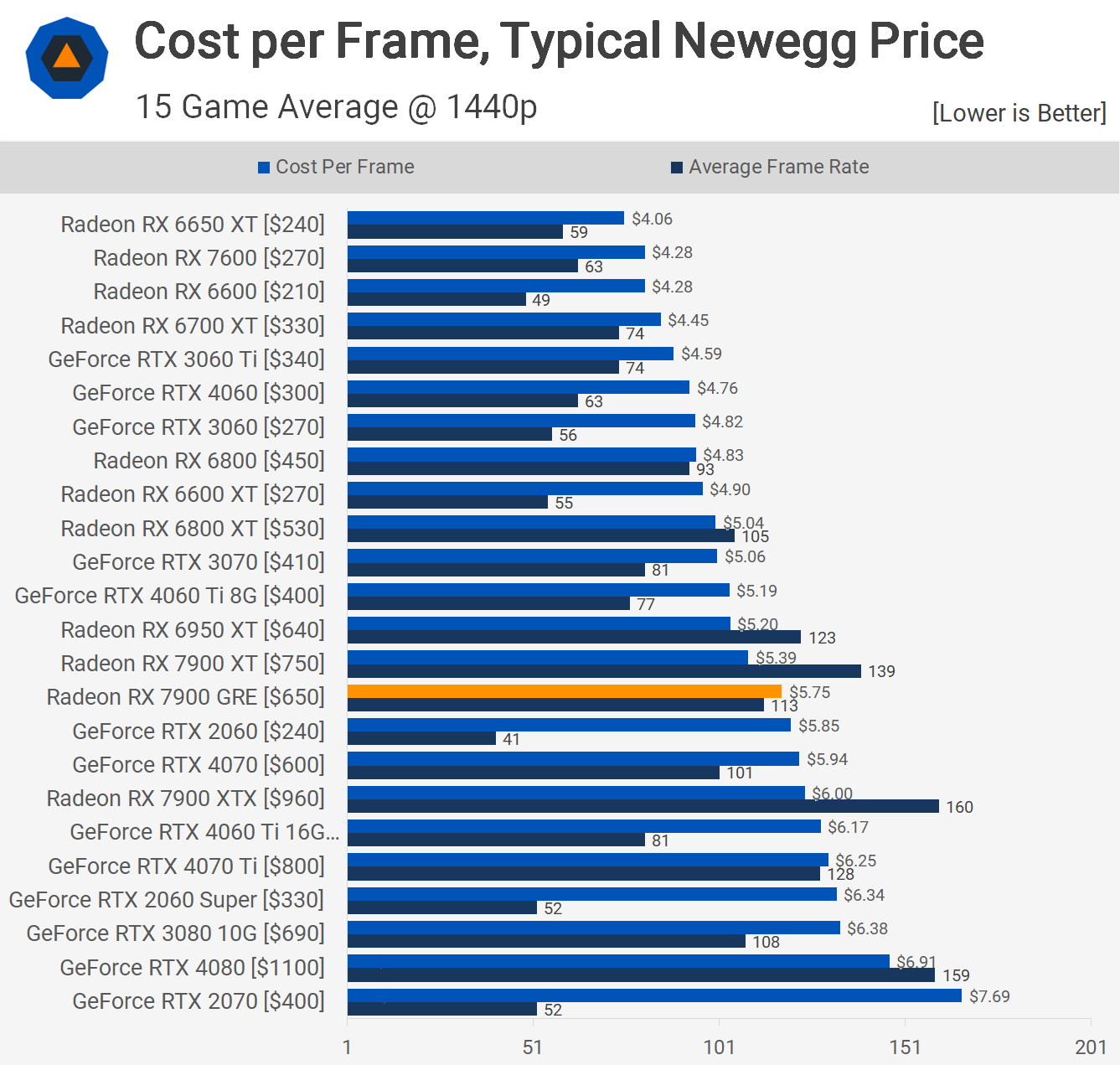
The GRE is currently 14% more costly per frame than the 6800 XT, so even if you could buy it, you’d likely be better off buying the older RDNA 2 GPU at the current discounted price of $530. Alternatively, the 7900 XT can be had for $750 and at that price it’s also better value than the GRE, you also get 20 GB of VRAM which probably isn’t all that important, but it’s a nice bonus for a product that’s already better value.
In short, if the GRE were available in the DIY market, its price point would need to be no more than $600 to be competitive with the $750 XT models and, of course, the outgoing 6800 XTs.
Power Consumption
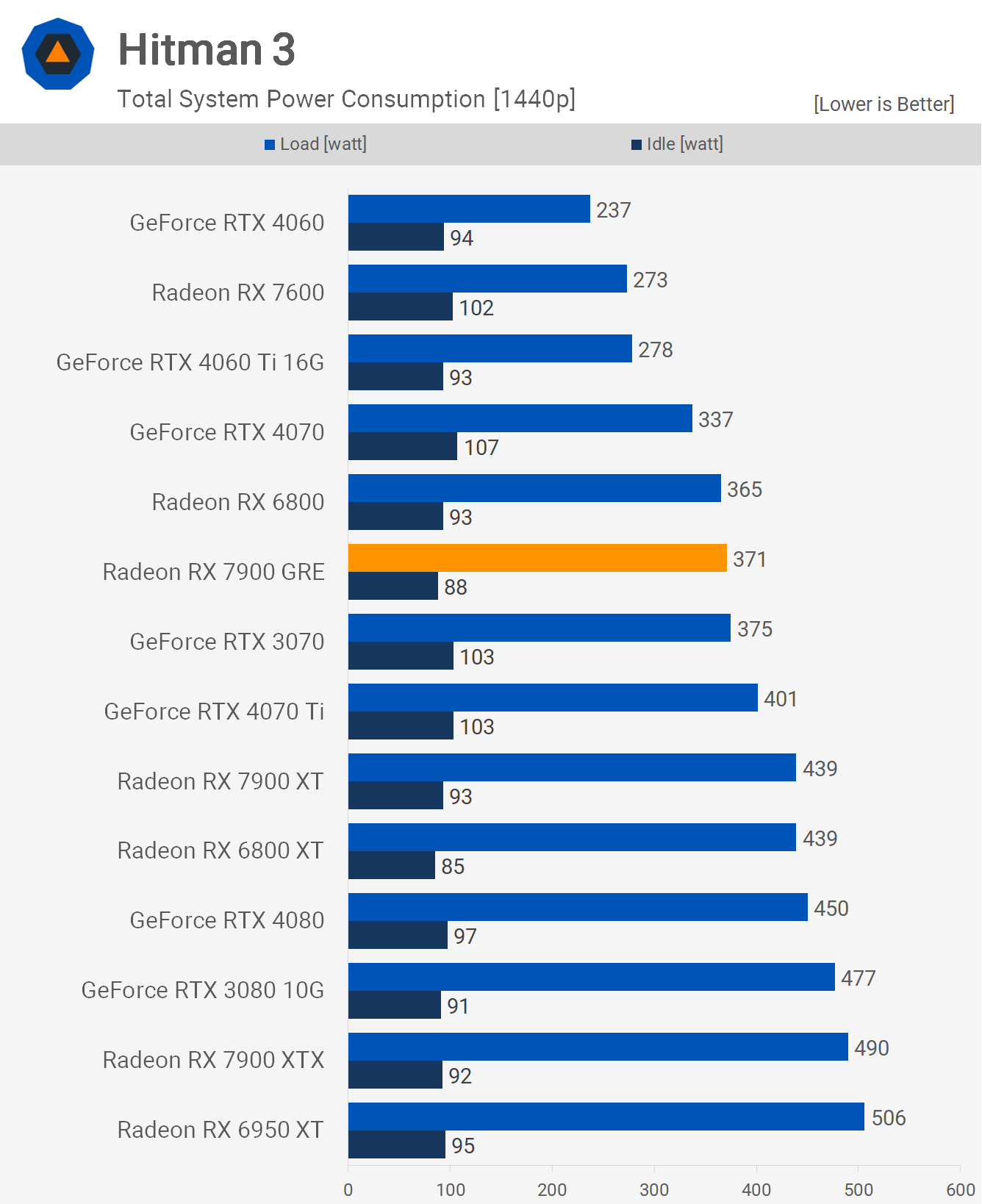
When compared to the outgoing 6800 XT, the big advantage of the 7900 GRE is power efficiency, though it’s probably not a big overall factor. In Hitman 3 we saw total system consumption reduced by almost 70 watts, a 15% power saving, so that’s nice.
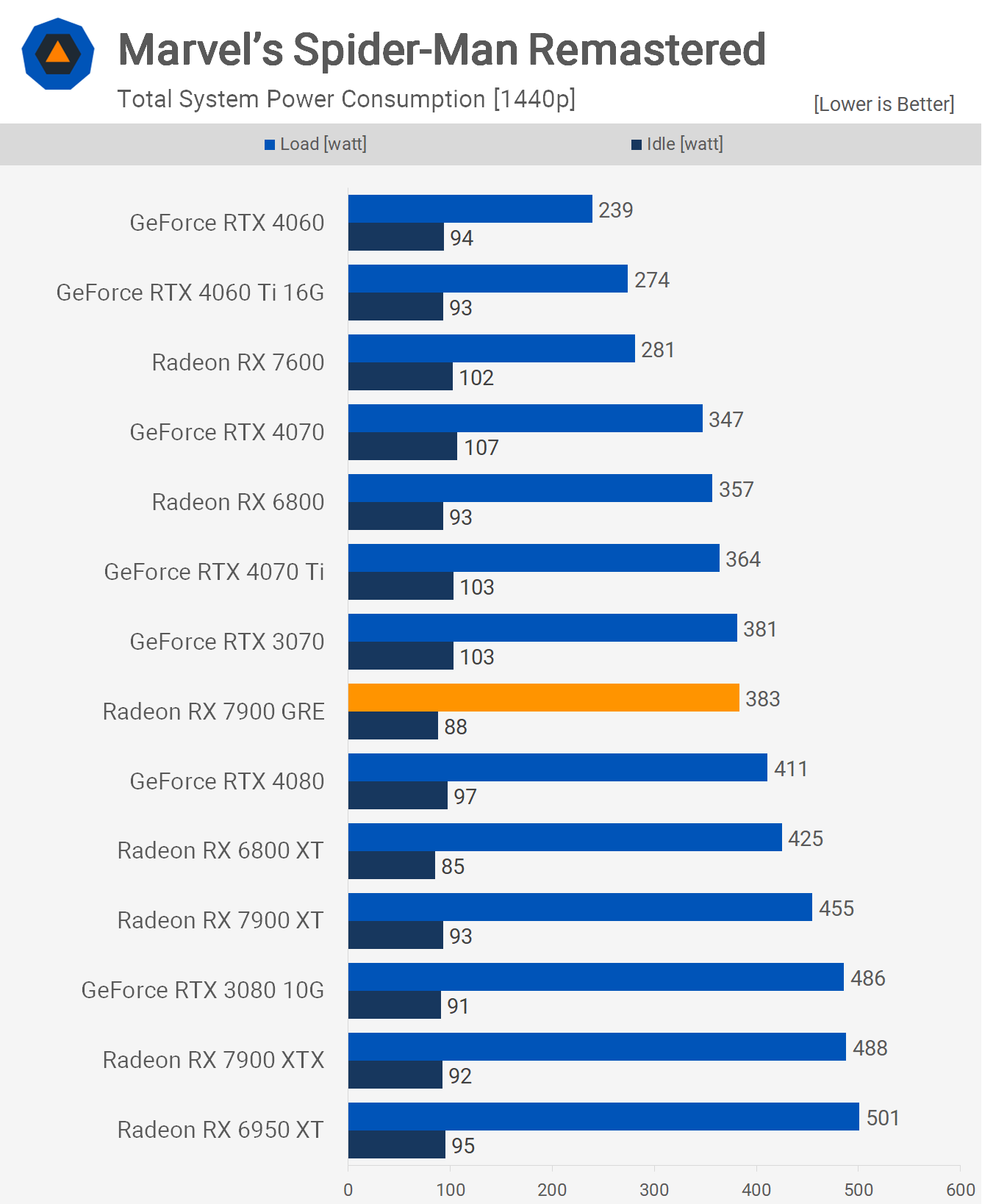
However, in Spider-Man Remastered, we noted only a 10% saving, amounting to around a 40-watt reduction. This suggests that the 7900 GRE won’t always be significantly more power-efficient than the 6800 XT, but overall, it’s undeniably the more efficient of the two.
The Reference Model
It’s our understanding that only AMD reference version of the GRE will be available, and that’s certainly the case for now. Also, only AMD and exclusive partners such as XFX, Sapphire and PowerColor will be selling the GRE.
In terms of design, the GRE reference model looks almost identical to the 7900 XT reference model, though there are some key differences. The GRE backplate measures 267mm long and 96mm wide, whereas the XT backplate is 276mm long and 99mm wide. The coolers are also very different, the GRE cooler weighs 737 grams whereas the XT cooler is 46% heavier at 1078 grams. Meaning, the XT is a slightly bigger and much heavier product.
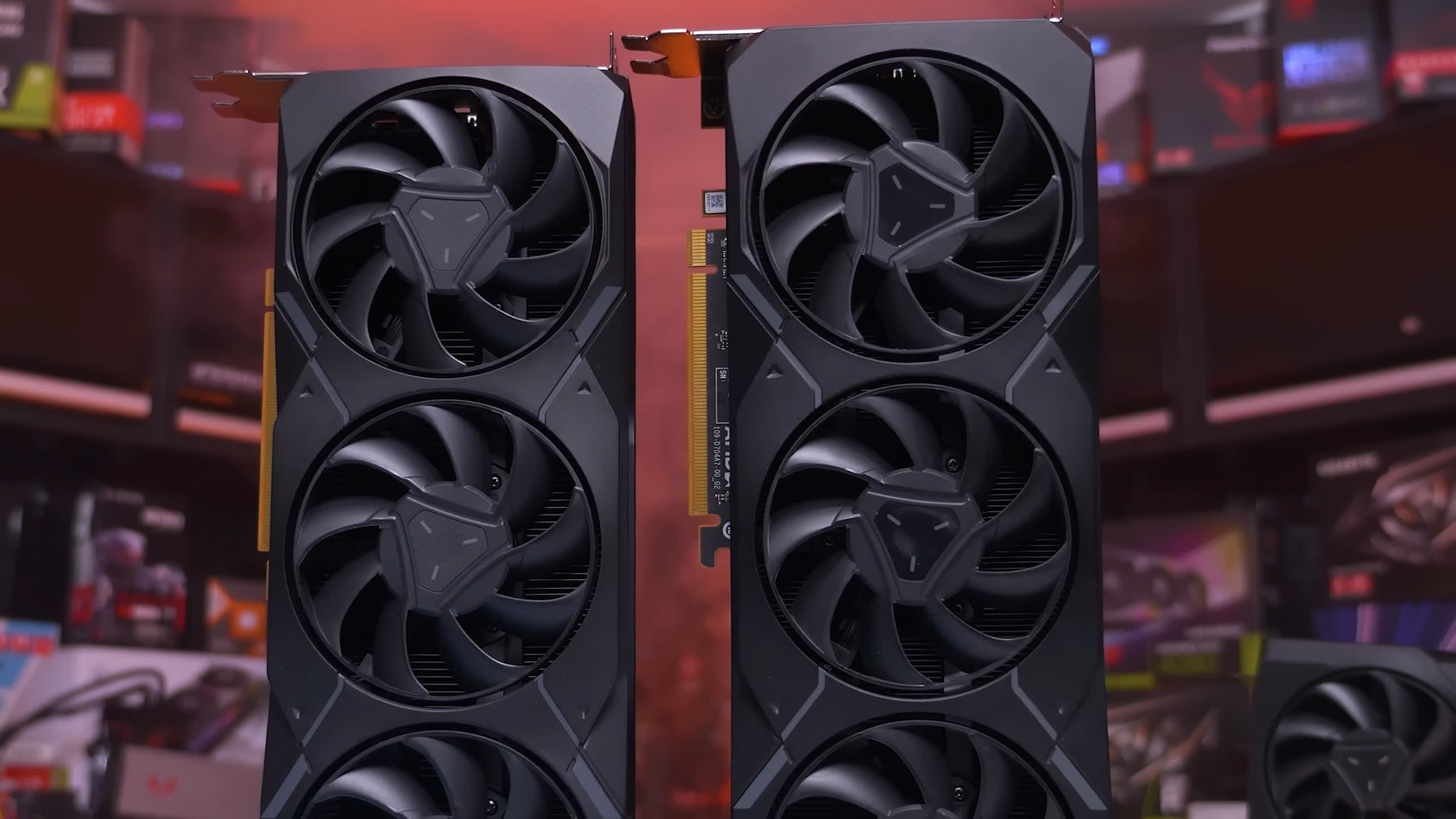
Over on the PCB, the GRE features 2 fewer power stages, and of course, there are two missing GDDR6 chips which reduce the capacity from 20 GB to 16 GB. As far as power input, it still uses two 8-pin PCIe connectors and then for I/O we find the exact same configuration.
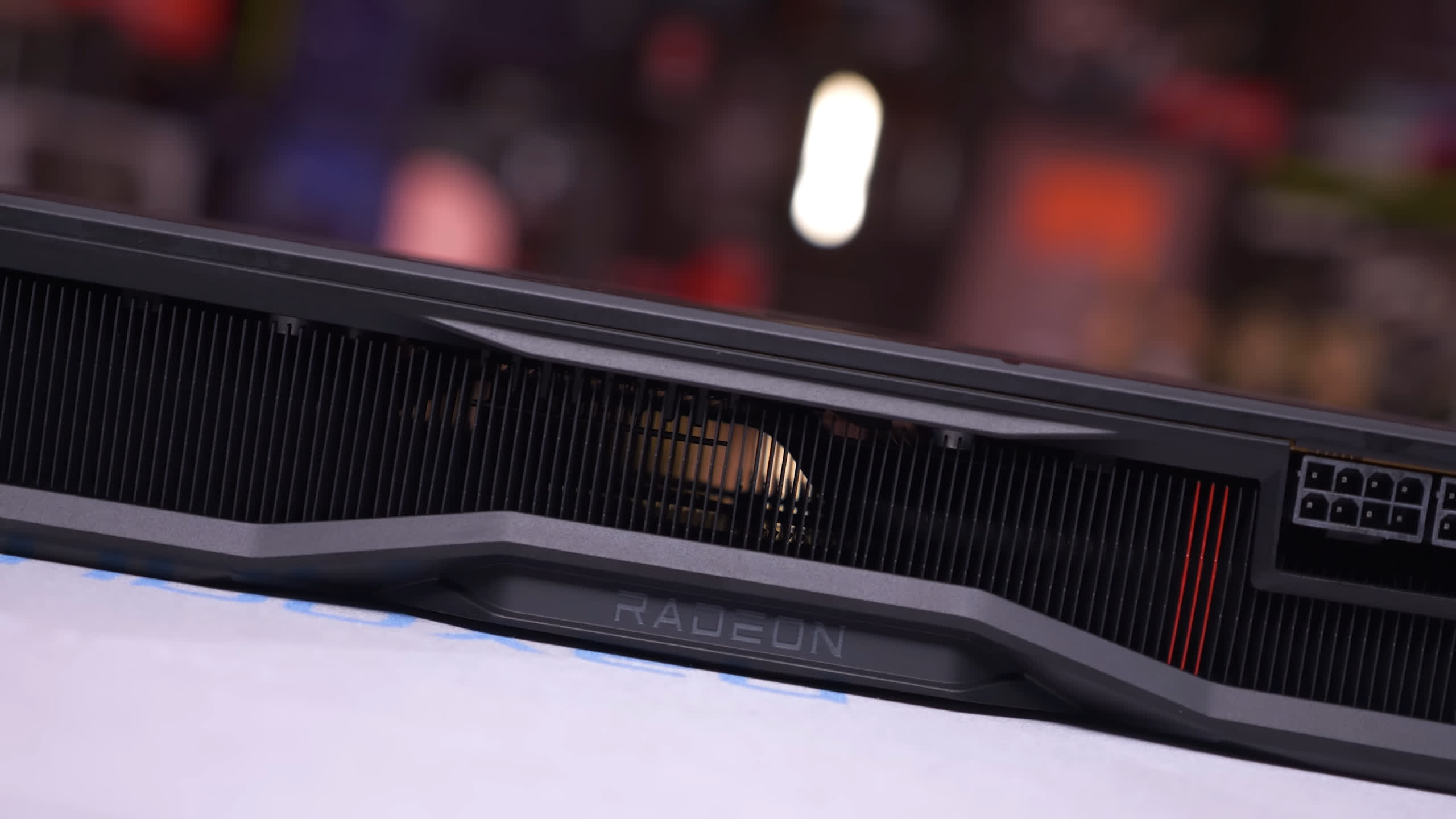
The only other noteworthy difference is the GPU itself. The GCD and MCD layout and dimensions are the same as the XT and XTX models, but as we noted earlier, two of the six MCDs are disabled.
But what’s really interesting is the package, where the XT sits on a 54mm x 47mm package, the GRE uses a much smaller one at 40mm x 39mm. This is likely the design we’ll see the Radeon 7800 XT adopt and with fewer active memory controllers we assume this is how AMD has been able to shrink the package.
Cooling
Here’s a quick look at the operating clock speeds and temperatures of the 7900 GRE reference card. After an hour of load we saw a peak hotspot temperature of 89c and a junction temperature of 75c.
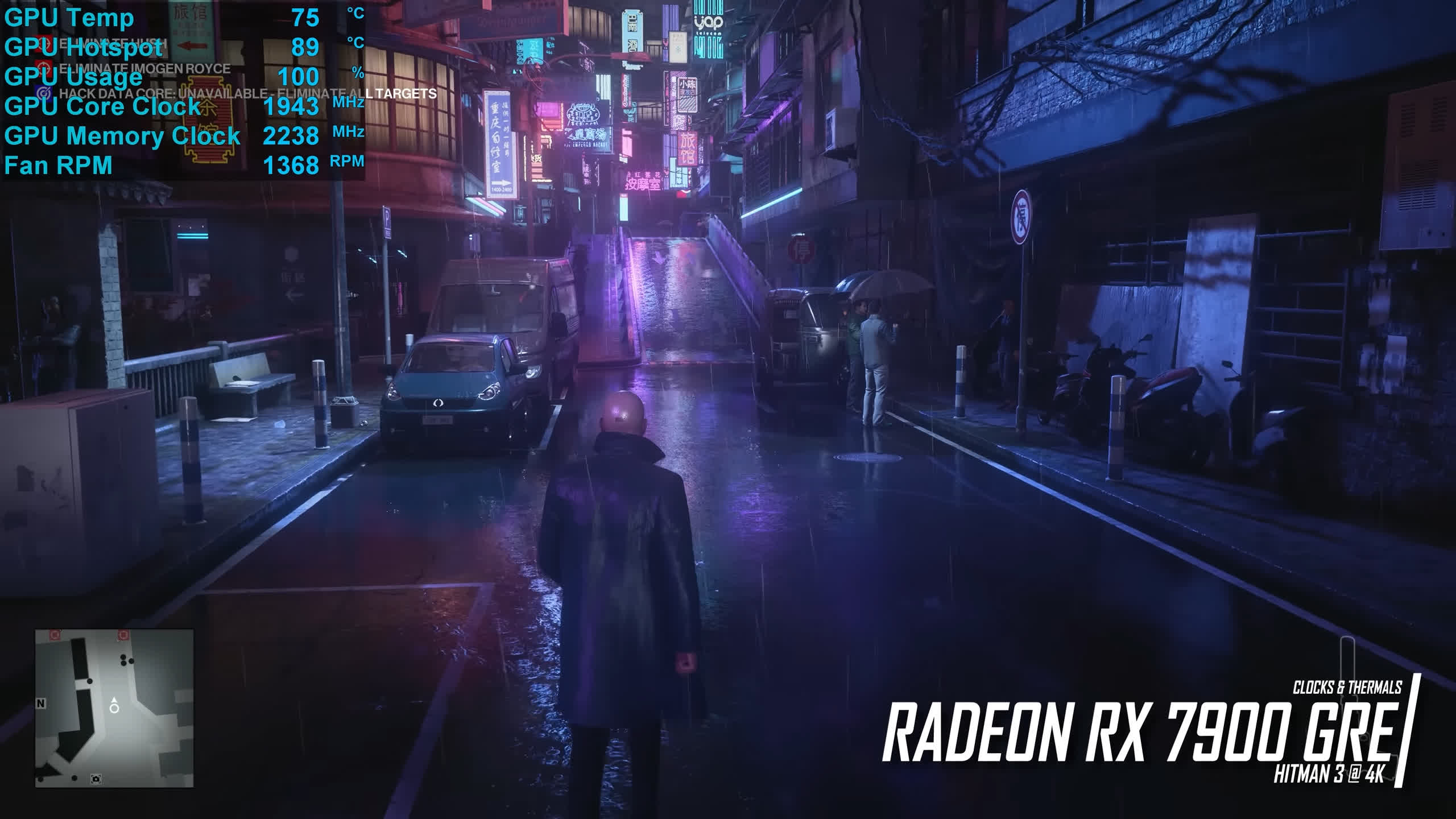
The peak temperature isn’t amazing though a fan speed of just under 1400 RPM is reasonably low and the card was certainly very quiet. The cores typically clocked at 1940 MHz, so about what we saw from the 7900 XT reference model and as expected the memory operated 18 Gbps. So overall decent results, but not nearly as good as many of the custom AIB 7900 XT’s.
What We Learned
Overall, the Radeon RX 7900 GRE is an unusual product. We wouldn’t label it as bad, but you might be better off avoiding it, given that discounted 7900 XT’s offer greater value. Alternatively, the Radeon 6800 XT provides nearly the same performance level at a considerably lower price.
In the PLE system we purchased, the 7900 GRE is priced at $1,100 AUD. Although PLE isn’t currently selling the 6800 XT, PC Case Gear is, with a tag of just $850 AUD. Based on our data, this means that in Australian dollars, the 7900 GRE costs $9.73 per frame, whereas the 6800 XT is priced at a mere $8.09 per frame. Consequently, the GRE comes with a 20% premium – quite steep.
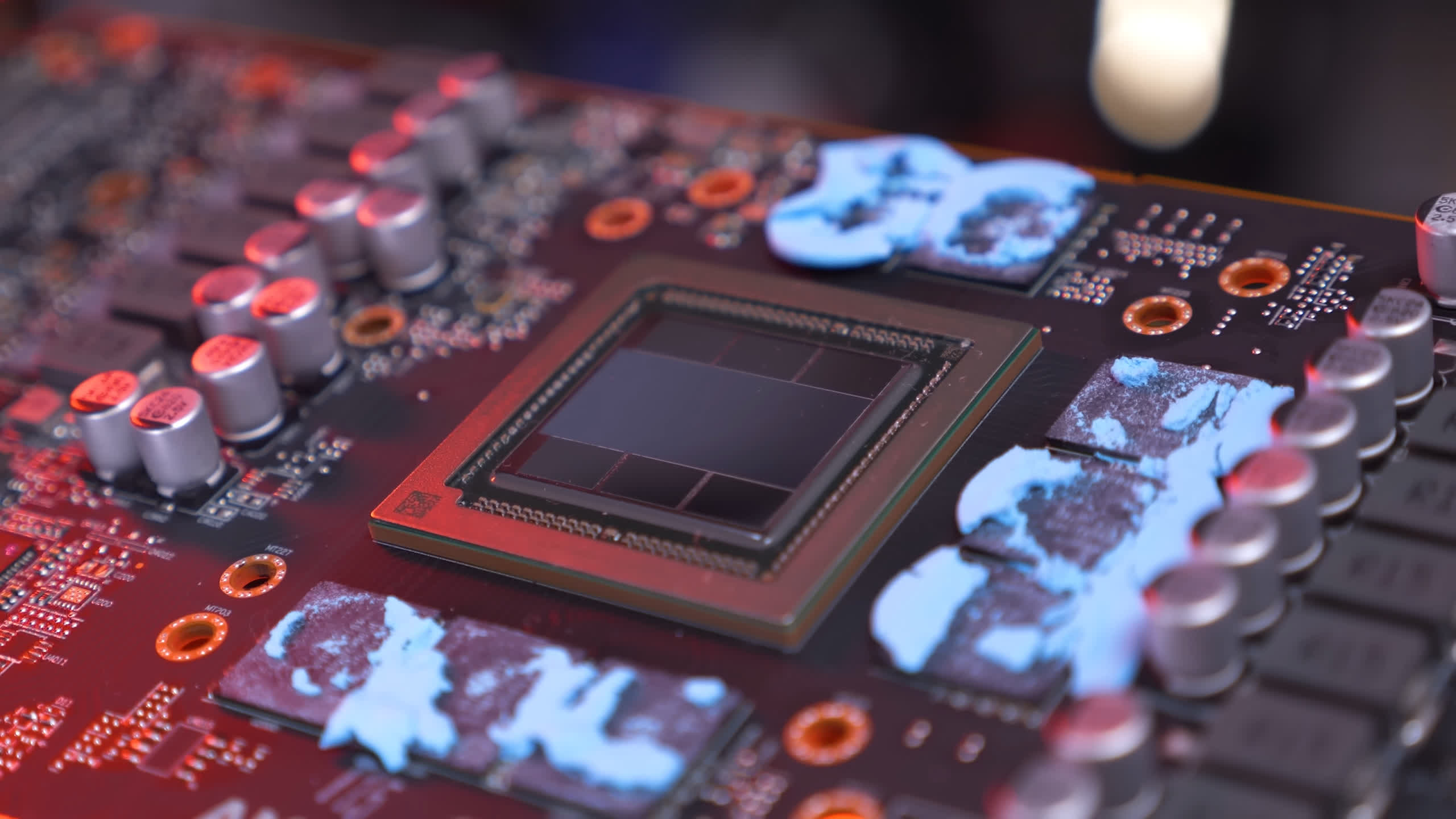
Furthermore, it’s feasible to acquire a 7900 XT for as low as $1,170 in Australia, making it only 6% pricier than the GRE. With a cost per frame of $8.41, one would naturally lean towards the 7900 XT when considering a current-generation GPU. However, in Australia, it’s advisable to scout around for those 7900 XT deals.
While there is stock available for the $1,170 models, both PC Case Gear and PLE have priced their 7900 XT’s closer to $1,300. Even at this rate, you’re examining a cost per frame of $9.35, which remains less than that of the GRE.
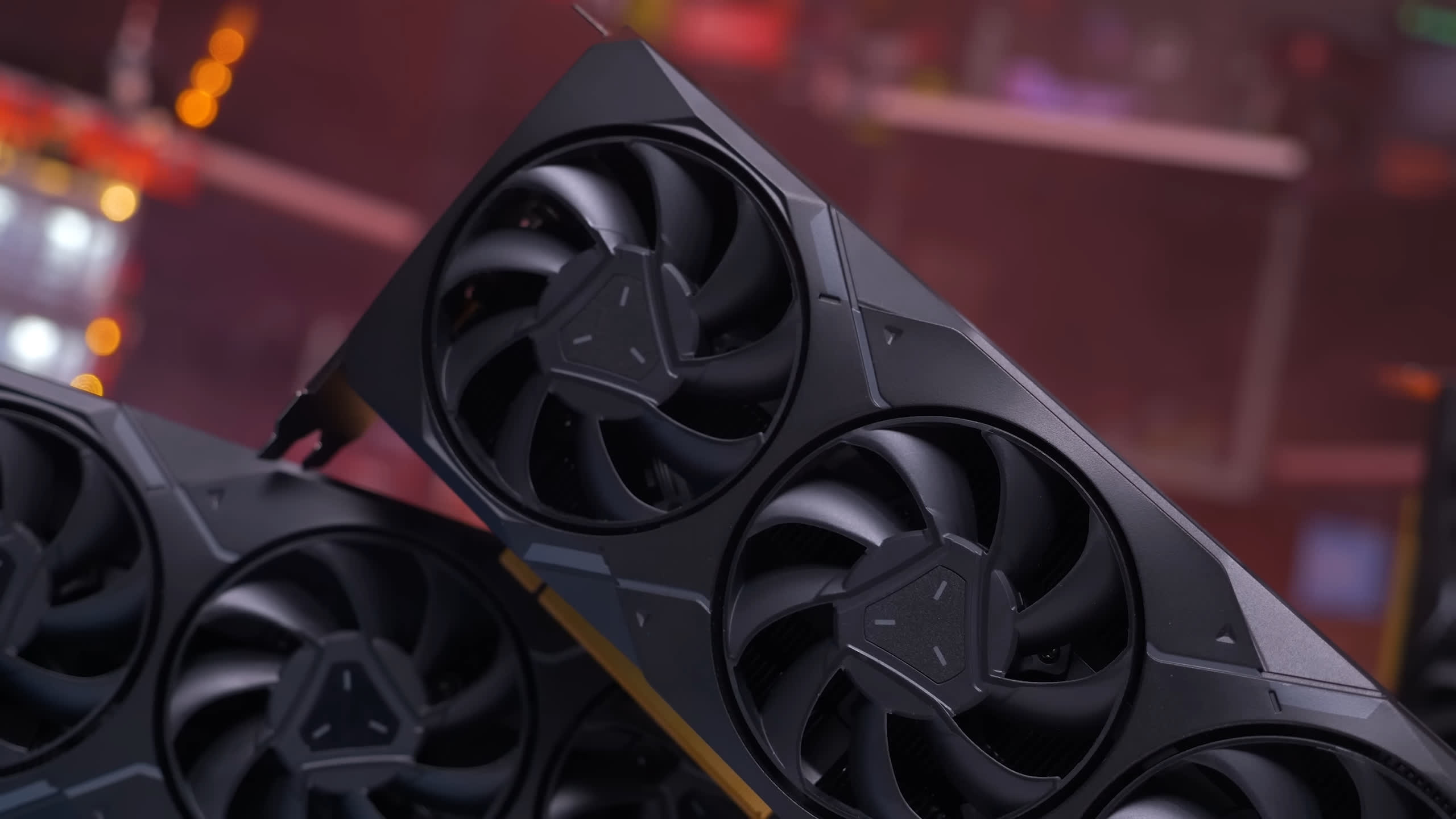
As we’ve mentioned, the 7900 GRE is an atypical product, and we’re ambivalent about it. We’re not keen on AMD’s selective sampling to reviewers and believe it’s in poor taste to release a product with a name so closely resembling existing products. It’s perplexing that this model is categorized under the 7900 series when it’s 20% less powerful than the 7900 XT, which is a trimmed version of the XTX, and it also possesses 20% less memory than the XT.
A more fitting designation would have been the 7800 GRE, or better yet, the Radeon RX 7800 XT, with wider availability. Nonetheless, we anticipate the launch of a product named the 7800 XT next month. It’ll be intriguing to gauge its performance relative to the 7900 GRE, and of course, its pricing.
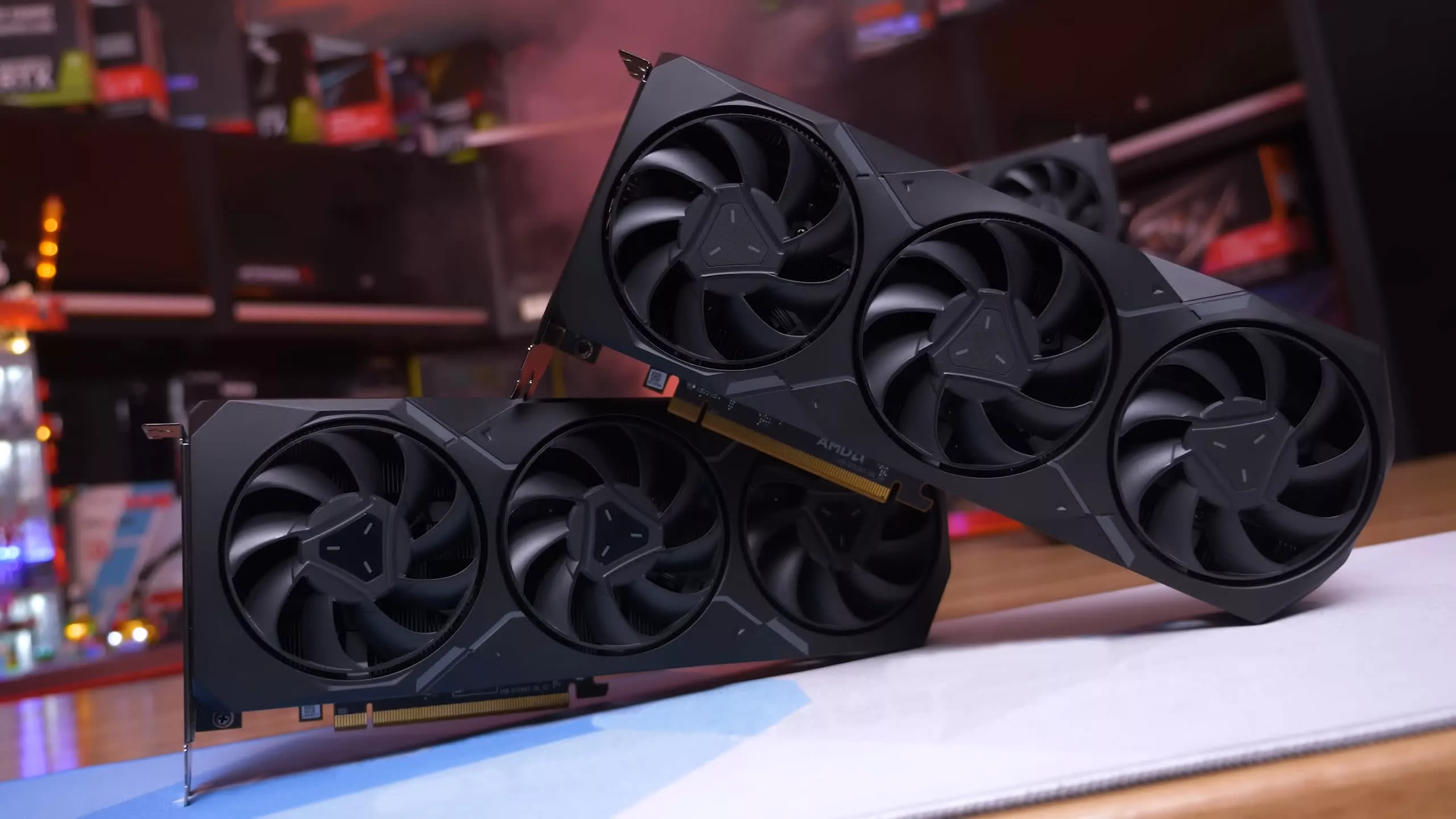
For now, our advice is to approach systems featuring the 7900 GRE with caution. Ensure you compare prices, as the 7900 XT or even 6800 XT could offer you more value. This wraps up our initial assessment of the 7900 GRE, but expect new mobile and desktop Radeons making it to the global market in the coming weeks and months.
Shopping Shortcuts:
- AMD Radeon RX 7900 XT on Amazon
- Nvidia GeForce RTX 4070 Ti on Amazon
- AMD Radeon RX 7600 on Amazon
- Nvidia GeForce RTX 4060 on Amazon
- Nvidia GeForce RTX 4070 on Amazon
- AMD Radeon RX 7900 XTX on Amazon
- Nvidia GeForce RTX 4090 on Amazon

